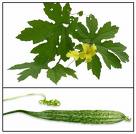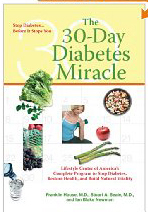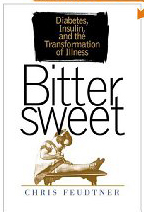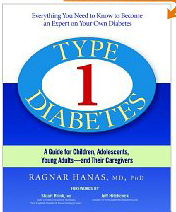Our Deadly Diabetes Deception
Greed and dishonest science have promoted a lucrative worldwide
epidemic of diabetes that honesty and good science can quickly reverse
by naturally restoring the body's blood-sugar control mechanism.The
classification of diabetes as a failure to metabolize carbohydrates
is a traditional classification that originated in the early 19th
century when little was known about metabolic diseases or about
metabolic processes.
Today, with our increased knowledge of metabolic
processes, it would appear quite appropriate to define Type 2 Diabetes
more fundamentally as a failure of the body to properly metabolize
fats and oils. This failure results in a loss of effectiveness of
insulin and in the consequent failure to metabolize carbohydrates.
Unfortunately, much medical insight into this matter, except at
the research level, remains hampered by its 19th century legacy.
Thus Type II Diabetes and its early hyperinsulinemic symptoms
are whole body symptoms of this basic cellular failure to properly
metabolize glucose. Each cell of our body, for reasons which are
becoming clearer, find themselves unable to transport glucose from
the blood stream to their interior. The glucose then either remains
in the blood stream, is stored as body fat or as glycogen, or is
otherwise disposed of in urine.
The goal of any effective alternative program is to repair and
restore the body’s own blood sugar control mechanism. It is the
malfunctioning of this mechanism that, over time, directly causes
all of the many debilitating symptoms that make orthodox treatment
so financially rewarding for the diabetes industry. For Type II
Diabetes, the steps in the program are: repair the faulty blood
sugar control system. This is done simply by substituting
clean healthy beneficial fats and oils
in the diet for the pristine looking but toxic trans-isomer mix
found in attractive plastic containers on room temperature supermarket
shelves. Consume only flax oil, fish oil and occasionally
cod liver oil until blood sugar starts to stabilize. Then add
back healthy oils such as butter, coconut oil, olive oil and
clean animal fat. Read labels; refuse to consume cheap junk oils
when they appear in processed food or on restaurant menus. Diabetics
are chronically short of vitamins and minerals; they need to add
a good quality broad spectrum supplement to the diet.
Dr. Robert Young states: "Excess acidity is a condition that
weakens all body systems. The pancreas is one of our body’s organs
charged with the awesome responsibility to alkalize us. Can you start to see how our
serious acidosis has overwhelmed our pancreas’
ability to operate effectively, which then results in a state called diabetes?”

The Role of Glutathione in Diabetes and Blood Sugar
"Diabetics are prone to infections and circulatory problems
leading to heart disease, kidney failure and blindness.
Glutathione protects against the
complications of diabetes" - Clinical Science 91: 575-582, 1996
To truly understand how glutathione plays major role diabetes health care you must first understand
some of the 'root causes' of diabetes within your body. Many people
mistakenly believe that diabetes simply 'happens', but this is rarely
the case. Sure, in some cases (very few) you may be pre-destined
for it through genetics, but their are many ways glutathione helps
diabetes in slowing down the symptoms or at least delaying the onset
of diabetes.
- Diabetics have high levels of oxidative stress. Oxidative
stress occurs in your body when the number of free radicals
exceeds the number of antioxidants that are present to neutralize
them. It has become widely known that long periods of oxidative
stress in your body can cause extremely high levels of cellular
inflammation. This inflammation left unaddressed within the
body has been shown to be a root cause of nearly every degenerative
disease such as; cancer, stroke, and heart disease.
- Inflammation leads to insulin resistance. Insulin
resistance occurs within your body when your pancreas is creating
insulin but it’s not able to use it properly to break down glucose.
This can directly lead to low levels of energy since glucose
is not being broken down utilized properly. At the later stages
of diabetes insulin resistance can lead to more serious health
concerns such as damage to the heart and blood vessels, high
cholesterol, high blood pressure and syndrome x(metabolic syndrome).
- Tests show diabetics have low levels of intracellular
glutathione. Glutathione is the body’s master antioxidant
controlling both oxidative stress and inflammation levels within
the body. This makes it critical for diabetics raise their levels
of glutathione to combat this condition. Each and every cell
within the body is responsible for producing its own glutathione
as long as it has the right nutrients to do so. As you can see,
glutathione plays a major role in diabetic health. Make sure
to get the right combination of nutrients each day to maximize
your glutathione levels. You’ll feel the difference!
Bitter Melon is Highly Prized for its Anti-Diabetic Activity
 Bitter
melon, Momordica charantia, (fruit and foliage) has been used
in the Orient as a traditional medicine for diabetes, gastrointestinal
therapy, cancer and viral infections. In Myanmar (Burma), China
and India, it is highly prized for its anti-diabetic activity.
Myanmar traditional physicians prescribe bitter melon to diabetic
patients. Doctors in India are so confident of bitter melon's
positive effect on diabetes, they dispense bitter melon in some
of the most modern hospitals. According to James Duke of U.S
Bitter
melon, Momordica charantia, (fruit and foliage) has been used
in the Orient as a traditional medicine for diabetes, gastrointestinal
therapy, cancer and viral infections. In Myanmar (Burma), China
and India, it is highly prized for its anti-diabetic activity.
Myanmar traditional physicians prescribe bitter melon to diabetic
patients. Doctors in India are so confident of bitter melon's
positive effect on diabetes, they dispense bitter melon in some
of the most modern hospitals. According to James Duke of U.S
 Department
of Agriculture, bitter melon has attained favor in China as
a monoherbal medicine for diabetes mellitus. Bitter melon has
twice the potassium of bananas, and it has been shown to increase
the number of beta cells, those which produce insulin, in the
pancreas.
Department
of Agriculture, bitter melon has attained favor in China as
a monoherbal medicine for diabetes mellitus. Bitter melon has
twice the potassium of bananas, and it has been shown to increase
the number of beta cells, those which produce insulin, in the
pancreas.
Bitter melong's common names and their associated cultures are:
- Ampalaya, Bitterweed: Southeastern US
- Serasee: Caribbean Islands
- Bitter melon: Oriental immigrants to the US
- Carillon: Latin America
- Mexicane: Cajun "traeteur" of Louisiana
- Kho Qua: Vietnam
- K'u Kua: China
- Ampalayo: Phillipines
- Kukakaya: India
- Also: Balsam Pear, Boston Apple, Bitter Gourd, Bitter Cucumber, Concombre Amer
 There
are a myriad of phytochemicals present in bitter melon and at
least three different groups of extracted components have been
reported to regulate and lower blood glucose levels. In 1999,
a Bangladeshi clinical trial was conducted to examine the effect
of Momordica charantia on 100 patients with Non-Insulin Dependent
Diabetes Mellitus (NIDDM) or Type 2 Diabetes. The researchers
recorded the patients’ sugar levels both without food intake
for 12-24 hours and after taking 75g of glucose. They then administered
a bitter melon pulp suspension to diabetic patients and 86 out
of the 100 responded to the vegetable intake, showing a significant
14% reduction in fasting and post-meal serum glucose levels.
There
are a myriad of phytochemicals present in bitter melon and at
least three different groups of extracted components have been
reported to regulate and lower blood glucose levels. In 1999,
a Bangladeshi clinical trial was conducted to examine the effect
of Momordica charantia on 100 patients with Non-Insulin Dependent
Diabetes Mellitus (NIDDM) or Type 2 Diabetes. The researchers
recorded the patients’ sugar levels both without food intake
for 12-24 hours and after taking 75g of glucose. They then administered
a bitter melon pulp suspension to diabetic patients and 86 out
of the 100 responded to the vegetable intake, showing a significant
14% reduction in fasting and post-meal serum glucose levels.
A recent 2004 study at the Devi Ahilya University in India
proved to have the same positive effects, where 15 men and women
with Type 2 Diabetes between the ages of 52 and 65 took 200mg
extracted constituents of bitter melon together with half doses
of either Metformin or Glibenclamide or a combination of both.
The result was a blood glucose level lower (hypoglycemia) than
what patients may acquire from taking full doses of Metformin
or Glibenclamide. It was likewise concluded that the vegetable
may enhance the hypoglycemic effect of the drugs should they
continue to use these prescription drugs. Several rat and hamster
trials taking Momordica charantia alone also yielded good results
in regulating glucose levels although animal studies may not
always hold true in humans.
 There
are a myriad of phytochemicals present in bitter melon and at
least three different groups of extracted components have been
reported to regulate and lower blood glucose levels. These involve
glucoside, a steroidal saponin-like substance called charantin;
alkaloids called momordicine that supress neural response to
sweet taste stimuli; and peptides mimicking the action of animal
insulin. As of July 2006, Liva Harinantenaina and a group of
Japanese researchers confirmed that the major pure cucurbutanoid
compounds of bitter melon possess hypoglycemic effects on blood
glucose levels. There is still a lingering obsurity on which
of these is most effective, if not all working synergistically.
There
are a myriad of phytochemicals present in bitter melon and at
least three different groups of extracted components have been
reported to regulate and lower blood glucose levels. These involve
glucoside, a steroidal saponin-like substance called charantin;
alkaloids called momordicine that supress neural response to
sweet taste stimuli; and peptides mimicking the action of animal
insulin. As of July 2006, Liva Harinantenaina and a group of
Japanese researchers confirmed that the major pure cucurbutanoid
compounds of bitter melon possess hypoglycemic effects on blood
glucose levels. There is still a lingering obsurity on which
of these is most effective, if not all working synergistically.
In 1999, a Bangladeshi clinical trial was conducted to examine
the effect of Momordica charantia on 100 patients with Non-Insulin
Dependent Diabetes Mellitus (NIDDM) or Type 2 Diabetes. The
researchers recorded the patients’ sugar levels both without
food intake for 12-24 hours and after taking 75g of glucose.
They then administered a bitter melon pulp suspension to diabetic
patients and 86 out of the 100 responded to the vegetable intake,
showing a significant 14% reduction in fasting and post-meal
serum glucose levels.
 A
recent 2004 study at the Devi Ahilya University in India proved
to have the same positive effects, where 15 men and women with
Type 2 Diabetes between the ages of 52 and 65 took 200mg extracted
constituents of bitter melon together with half doses of either
Metformin or Glibenclamide or a combination of both. The result
was a blood glucose level lower (hypoglycemia) than what patients
may acquire from taking full doses of Metformin or Glibenclamide.
It was likewise concluded that the vegetable may enhance the
hypoglycemic effect of the drugs should they continue to use
these prescription drugs. Several rat and hamster trials taking
Momordica charantia alone also yielded good results in regulating
glucose levels although animal studies may not always hold true
A
recent 2004 study at the Devi Ahilya University in India proved
to have the same positive effects, where 15 men and women with
Type 2 Diabetes between the ages of 52 and 65 took 200mg extracted
constituents of bitter melon together with half doses of either
Metformin or Glibenclamide or a combination of both. The result
was a blood glucose level lower (hypoglycemia) than what patients
may acquire from taking full doses of Metformin or Glibenclamide.
It was likewise concluded that the vegetable may enhance the
hypoglycemic effect of the drugs should they continue to use
these prescription drugs. Several rat and hamster trials taking
Momordica charantia alone also yielded good results in regulating
glucose levels although animal studies may not always hold true
Bitter melon is available through most Filipino and/or Asian
grocery stores, and some farmers markets. Because the plant
is seasonal and is difficult to grow in the winter, it is sometimes
sold frozen. The appropriate method of administering bitter
melon is to make the extract from the fruit,
vines, and leaves of the plant and either drink it as a juice,
tea or administer it as a retention enema. Some say that drinking
the juice or tea will result in the breakdown of the active
components by stomach acids, therefore a retention enema would
be a more efficient route.
Contraindications:
- Do not use if pregnant or breast feeding.
- This plant has been documented in animal studies to reduce
fertility in both males and females and should
therefore not be used by those undergoing fertility treatment
or seeking pregnancy.
- Bitter melon has demonstrated in animal and human studies
that it lowers blood sugar levels. As such, it
is contraindicated in persons with hypoglycemia. Diabetics should
use with caution while monitoring their
blood sugar levels regularly.
- Drug Interactions: It may potentiate insulin and anti-diabetic drugs.

The Role of Marine Phytoplankton in Diabetes
 Also rich in Omega three fatty acids, Phytoplankton micronutrients reduces
the levels of sugar in the bloodstream of the diabetic patient.
The most renown feature of Marine Phytoplankton
as one of the natural cures for diabetes is that it not only improves
the blood sugar levels, but it also prevents the usual complications
that arise from diabetes. Testimonials show dramatic changes in glucose levels of those who choose to use
marine phytoplankton,
although it must already be established as one's maintenance intake
for diabetics because losing the supply of marine phytoplankton
may spike glucose levels at abnormal levels again.
Also rich in Omega three fatty acids, Phytoplankton micronutrients reduces
the levels of sugar in the bloodstream of the diabetic patient.
The most renown feature of Marine Phytoplankton
as one of the natural cures for diabetes is that it not only improves
the blood sugar levels, but it also prevents the usual complications
that arise from diabetes. Testimonials show dramatic changes in glucose levels of those who choose to use
marine phytoplankton,
although it must already be established as one's maintenance intake
for diabetics because losing the supply of marine phytoplankton
may spike glucose levels at abnormal levels again.
Type I, or Juvenile Diabetes, is defined
by the pancreas losing its ability to produce insulin. It is more
severe than Type II, which is characterized by insulin resistance
at the cell membrane level. Inflammation, oxidation,
mitochondrial dysfunction, and toxicity of the cell membrane
result in pancreatic dysfunction, and insulin resistance in each
cell of our bodies, thereby explaining the problems seen with both types of diabetes.
Phytoplankton micronutrients
can help restore function to the cell by correcting those issues
with its high content of antioxidants, anti-inflammatory nutrients,
and its ability to enhance detoxification pathways in the liver,
intestines, kidneys and skin; energy-producing pathways in the mitochondria
are also enhanced.
Some people worry that the transient elevation of blood sugar
noted while consuming fruits in general, is a sign that these foods
are not good for diabetics. As noted on the front cover of the March
2005 issue of the Journal Neuron, this reasoning is not justified.
In fact, this very misconception leaves people to lack antioxidants
that are essential to build and fuel their cell membranes. Furthermore,
they end up dissatisfied and craving sugar in general, and refined
foods in particular. And so it is that they succumb to the temptation
of eating simple carbohydrates, and processed foods high in
refined sugars. They would have been better off satisfying their sweet tooth with fruits.

Omega 3 oils - Flaxseed oil, Borage oil, Helps Prevent Diabetes
Results of GLA (gamma linolenic acid) as found in flax oil,
fish oil and evening primrose oil supplementation in diabetics truly
astounding!
Stein et al, in their research at the Department of Internal
Medicine, Center for Diabetes Research at the University of Texas
Southwestern Medical Center Dallas Texas have conclusively demonstrated
the vital importance of oils that contain the essential Omega three fatty acids.
 These Omega three’s as well as an important Omega six are the EFA’s LNA
and LA. When we lack them in our diet, we suffer degenerative disease
These Omega three’s as well as an important Omega six are the EFA’s LNA
and LA. When we lack them in our diet, we suffer degenerative disease
Research shows the role certain beneficial fatty acids may play
in preventing or improving cardiovascular complications attributed
to diabetes. "Perhaps of equal or greater importance is the role
certain beneficial fatty acids may play in preventing or improving
cardiovascular complications attributed to diabetes. Buried in the
annals of medicine are extremely optimistic studies attesting to
these facts. This information has not been widely publicized in
the past because fatty acids are naturally occurring nutrients and
can not be patented by pharmaceutical companies and sold at exorbitant
prices. One such fatty acid, gamma linolenic acid (GLA), is found
in nature's most concentrated form as Borage seed oil (24% GLA).
The results of GLA supplementation in diabetics are truly astounding,
as outlined below. Diabetic neuropathy (a painful nerve disorder
resulting from reduced blood flow and subsequent oxygen depravation
of the limbs or organs) was reversed in studies conducted by seven
medical centers. In a separate, but similar study, 12 patients afflicted
with diabetic neuropathy were given 360 mg of GLA daily (the equivalent
of two, 1000 mg. Borage oil capsules), while 10 others were given
a placebo (inactive substance). After 6 months the GLA group showed
statistically significant improvement as compared to the placebo
group. In addition, GLA supplementation has been reported to normalize
the faulty fatty acid metabolism attributed to diabetes by bypassing
the enzyme system responsible for this disorderBy doing so the body's
response to inflammation, pain and swelling is stabilized. Arterial
muscle tone, responsible for blood pressure and optimal circulation,
is also regulated by this system. Animal studies conducted with
GLA have revealed the normalization of intercellular sorbitol levels.
Another study of Type 1 diabetics cited favorable changes in HDL
("good" cholesterol) and blood platelet adhesiveness
In summary, diabetics have been found to possess faulty fatty
acid metabolism which may contribute to the cardiovascular complications
associated with the disease. Scientific research has established
the reduction of certain harmful fats, with the addition of beneficial
fatty acids, may offer a significant breakthrough in combating diabetic
cardiovascular complications with the potential of significantly
lowering health care costs." The study concluded that all diabetics should be considered for
a dietary protocol of GLA.
 "The degenerative disease epidemic that wracks the nation came coincidentally
with the introduction of engineered
trans fats and oils. It is the type of fats and oils that we consume
that is directly correlated to the rise of epidemic degenerative
disease; it is not the amount of fats and oils that we eat that
causes the problem. It is by chronically consuming the fats and
oils that cause degenerative disease that we impair our ability
to consume healthy fats and oils. We also impair our ability to
consume carbohydrates and thus become" Diabetic and Obese" Thomas
Smith, author of Insulin: Our Silent Killer
"The degenerative disease epidemic that wracks the nation came coincidentally
with the introduction of engineered
trans fats and oils. It is the type of fats and oils that we consume
that is directly correlated to the rise of epidemic degenerative
disease; it is not the amount of fats and oils that we eat that
causes the problem. It is by chronically consuming the fats and
oils that cause degenerative disease that we impair our ability
to consume healthy fats and oils. We also impair our ability to
consume carbohydrates and thus become" Diabetic and Obese" Thomas
Smith, author of Insulin: Our Silent Killer
An item reported in the British Journal of Nutrition during a
four-week study indicated that flax oil
was beneficial in helping to regulate blood glucose levels in diabetics.
Because most Americans consume highly processed refined oils, many
are deficient in Omega-3 fatty acids that may provide numerous health
benefits to people with high cholesterol, heart disease, stroke,
angina, high blood pressure, rheumatoid arthritis, multiple sclerosis,
psoriasis and eczema, and cancer. Flaxseeds, an unrefined food,
provide the richest source of Omega-3 fatty acids.

Diabetes and Magnesium: The Emerging Role of Oral Magnesium Supplementation
Type 2 diabetes is associated with low
levels of magnesium in the blood. A large clinical study of
over 2000 people found that higher dietary
intake of magnesium may
protect against development of type 2 diabetes. Magnesium was found
to improve insulin sensitivity in these people, reducing the risk
of developing type 2 diabetes. Other clinical studies have found
similar results, especially in the elderly. Magnesium deficiency
in diabetic patients may decrease their immunity, making them more
susceptible to infections and illnesses.
Jerry L. Nadler, MD - The link between diabetes mellitus
and magnesium deficiency is well known.
A growing body of evidence suggests that magnesium plays a pivotal
role in reducing cardiovascular risks and may be involved in the
pathogenesis of diabetes itself. While the benefits of oral magnesium
supplementation on glycemic control have yet to be demonstrated
in patients, magnesium supplementation has been shown to improve
insulin sensitivity. Based on current knowledge, clinicians have
good reason to believe that magnesium repletion may play a role
in delaying type 2 diabetes onset and potentially in warding off
its devastating complications -- cardiovascular disease, retinopathy,
and nephropathy.
Fish Oil and Diabetes
 Population studies have suggested that
fish oil
might help protect against diabetes. "There were epidemiological studies on the Greenland Eskimos, a population of people that eat
mainly whale blubber. In a study, researchers had 12 overweight
men and women, aged 40 to 70, consume 1.8 grams of DHA at breakfast
for 12 weeks. While none of the study participants had full-blown
diabetes, they all suffered from insulin resistance -- a pre-diabetic
condition in which the body fails to efficiently respond to insulin.
Using blood tests taken at the start and end of the study, the researchers
assessed changes in each person's insulin resistance. They saw a
change in insulin sensitivity after 12 weeks of DHA supplementation.
A full 70% of the study participants showed an improvement in insulin-related
function, and in 50% it was a clinically significant change. Annual
Experimental Biology 2002 Conference New Orleans, LA April 21, 2002
Population studies have suggested that
fish oil
might help protect against diabetes. "There were epidemiological studies on the Greenland Eskimos, a population of people that eat
mainly whale blubber. In a study, researchers had 12 overweight
men and women, aged 40 to 70, consume 1.8 grams of DHA at breakfast
for 12 weeks. While none of the study participants had full-blown
diabetes, they all suffered from insulin resistance -- a pre-diabetic
condition in which the body fails to efficiently respond to insulin.
Using blood tests taken at the start and end of the study, the researchers
assessed changes in each person's insulin resistance. They saw a
change in insulin sensitivity after 12 weeks of DHA supplementation.
A full 70% of the study participants showed an improvement in insulin-related
function, and in 50% it was a clinically significant change. Annual
Experimental Biology 2002 Conference New Orleans, LA April 21, 2002
Note: Too much of a good thing... "Omega-3 fish oil is
terrific for most of us, but if we get too much it actually
worsens our health. If you are diabetic you will want to monitor
your sugar levels very carefully when you use fish oil, and you
will need to lower or stop the fish oil if your blood sugar rises."
Dr. Mercola
Insulin Resistant Diabetes
Thomas Smith
Insulin Resistant Diabetes or Hyperinsulinemia is known to the
medical community by the symptoms that it produces. Some of these
symptoms are: Atherosclerosis, Vascular disease, Diabetes type 2,
Impotence, Kidney Failure, Heart Failure, Liver Damage, Stroke,
Obesity, Neuropathy, Retinopathy and Gangrene to name but a few.
Hyperinsulinemia is also thought to be implicated in several forms
of Cancer and in the epidemic of Attention Deficit Hyperactivity
Disorder (ADHD) raging through our schools today; although with
these latter two diseases, the evidence while quite compelling is
not yet completely conclusive.
 The good news is that although this disease accounts for almost
half of the annual death toll from all causes, it is, in most cases,
curable- permanently, quickly, economically, completely and often
easily and by natural means. That means little or no reliance upon
synthetic designer drugs and no ineffective medical treatments for
symptoms while causal agents remain untreated. It is now possible
to look forward to something other than a rapid decline to invalid
status and an early painful death.
The good news is that although this disease accounts for almost
half of the annual death toll from all causes, it is, in most cases,
curable- permanently, quickly, economically, completely and often
easily and by natural means. That means little or no reliance upon
synthetic designer drugs and no ineffective medical treatments for
symptoms while causal agents remain untreated. It is now possible
to look forward to something other than a rapid decline to invalid
status and an early painful death.
To cure Hyperinsulinemia, Type II Diabetes, Syndrome X and many
other consequential diseases that stem from poisonous fats and oils,
it is important to realize that the chronic ingestion of Refined
and Hydrogenated fats and oils is implicated as a causal agent in
these diseases. Margarine, artificial shortenings, refined oils
and all Hydrogenated edible products are long term toxic to the
human metabolism. An important consideration about these edible
oils is a widespread fraudulent advertising technique that enables
the oils manufacturer to sell known toxic oils to the unsuspecting
public without breaking the law. Many refined vegetable oils are
advertised as monounsaturated or as polyunsaturated in order to
confuse the purchaser. From my own research of the scientific literature
when I was forced to find a cure for my own Type II Diabetes, I
know that this Trans configuration is a major cause of Type II Diabetes.
I also know that the complete removal of these toxic fats and oils
and the consumption of therapeutic quantities of the EFA’s rapidly
leads to reversal of Type II Diabetes. Thomas Smith is the author of: 'Insulin: Our Silent Killer'

Human clinical studies show Fulvic acids offer significant help with Diabetes mellitus
Diabetes mellitus stems from dietary deficiency of protective
humic substances, especially fulvic acids. Scientists found that
fulvic acids show significant success in preventing and combating
free radical damage to pancratic islet B cells, which is the widely
accepted cause for diabetes mellitus. What they discovered was that
the Fulvic acid preparation significantly increases superoxide dismutase
(SOD) activity. Their clinical studies show that fulvic acids diminish
the development and progression of diabetes, and assisted
in the treatment. With fulvic acid, diabetes patients became
more energetic and the tingling, painful feeling and numbness experienced
in the nerve endings disappeared or were reduced. For centuries
people living in isolated villages in the Himalayas and adjoining
regions have used preparations made from a rare fulvic acid containing
humic substance known as Shilajit, to prevent
and combat problems with diabetes. Diabetes is quite uncommon
in the isolated mountain villages, yet a brisk trade in these rare
fulvic acid containing preparations has expanded in recent years
to the traditional doctors in surrounding regions.
Diabetes Mellitus, Type 1 (juvenile diabetes)

People with type I diabetes mellitus (insulin-dependent diabetes)
produce little or no insulin at all. In type II
diabetes mellitus (non-insulin-dependent diabetes), the pancreas
continues to manufacture insulin, sometimes even at higher than
normal levels. However, the body develops resistance to its effects
and the sugar in the blood does not enter the cells as well as it
should resulting in higher blood sugar levels. Type II diabetes
usually begins after age 30 and becomes progressively more common
with age. Obesity is a risk factor for type II diabetes; 80 to 90
percent of the people with diabetes are obese.
Diabetes mellitus (DM) is a chronic metabolic disorder caused
by an absolute or relative deficiency of insulin, an anabolic hormone.
Insulin is produced by the beta cells of the islets of Langerhans
located in the pancreas, and the absence, destruction, or other
loss of these cells results in type 1 diabetes (insulin-dependent
diabetes mellitus [IDDM]). Most children with diabetes have IDDM
and a lifetime dependence on exogenous insulin.
Vaccines Proven To be Largest Cause of Insulin Dependent Diabetes in Children
In the May 24, 1996 New Zealand Medical Journal, Dr. Classen reported
that there was a 60 percent increase in Type I diabetes (juvenile
diabetes) following a massive campaign in New Zealand from 1988
to 1991 to vaccinate babies six weeks of age or older with hepatitis
B vaccine. His analysis of a group of 100,000 New Zealand children
prospectively followed since 1982 showed that the incidence of diabetes
before the hepatitis B vaccination program began in 1988 was 11.2
cases per 100,000 children per year while the incidence of diabetes
following the hepatitis B vaccination campaign was 18.2 cases per
100,000 children per year. Diabetics Advised to Seek Legal Counsel
Now, Before Their Right to Compensation Expires. Dr. Classen presented
data supporting a causal relationship between many different vaccines
and the development of insulin diabetes. His data included the pertussis,
mumps, rubella, hepatitis B, hemophilus influenza and others. The
data indicated people with vaccine induced diabetes may not develop
the disease until 4 or more years after receiving a vaccine. Lawyers
attending the conference and who reviewed the data, advise diabetics
to seek legal counsel at once. The government provides compensation
for vaccine induced injuries however there is a statute of limitations.
Insulin dependent diabetes cost the patient about $1 million over
their life time.
Soy and Type 1 Diabetes in Children
Contrary to popular belief that soy is a health food, evidence reveals
that soy consumption has been linked to numerous disorders, including
infertility, increased cancer and infantile leukemia,
Type1 diabetes, and precocious puberty in children have been fed soy formula.
A combined research team of Cornell University Medical College
and Long Island Community Hospital medical experts have found that children
 who develop Type1 diabetes are twice as likely to have been fed
soy formulas as those fed all other foods This confirms concerns
based on animal studies raised in the 1980's and 1990s by Health
Canada researcher Dr Fraser Scott and led to the American Academy
of Pediatrics issuing their warning to pediatricians against any
use of soy based formulas. Scientists have known for years that
the isoflavones in soy products can depress thyroid function
and cause goiters in otherwise healthy children and adults. Researchers
at Cornell University Medical College said that children who got
soy formula were more likely to develop thyroid disease and that
twice as many diabetic children had received soy formula in infancy
as compared to non-diabetic children. In fact, in other countries
such as Switzerland, England, Australia and New Zealand, public
health officials recommend highly restricted medically monitored
use of soy for babies and for pregnant women. Soy formula is a lifesaver
for the 3 to 4 percent of babies allergic to cows milk, but it is
so widely advertised that it is sold to 25% of the entire formula market.
who develop Type1 diabetes are twice as likely to have been fed
soy formulas as those fed all other foods This confirms concerns
based on animal studies raised in the 1980's and 1990s by Health
Canada researcher Dr Fraser Scott and led to the American Academy
of Pediatrics issuing their warning to pediatricians against any
use of soy based formulas. Scientists have known for years that
the isoflavones in soy products can depress thyroid function
and cause goiters in otherwise healthy children and adults. Researchers
at Cornell University Medical College said that children who got
soy formula were more likely to develop thyroid disease and that
twice as many diabetic children had received soy formula in infancy
as compared to non-diabetic children. In fact, in other countries
such as Switzerland, England, Australia and New Zealand, public
health officials recommend highly restricted medically monitored
use of soy for babies and for pregnant women. Soy formula is a lifesaver
for the 3 to 4 percent of babies allergic to cows milk, but it is
so widely advertised that it is sold to 25% of the entire formula market.